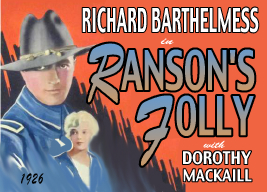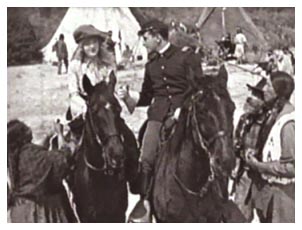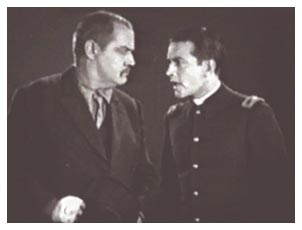

Distributed by First National Pictures
Premiere: May 30, 1926
Directed by Sidney Olcott
Cast: Richard Barthelmess (Lt. Ranson), Dorothy Mackaill (Mary
Cahill), Anders Randolf (Cahill, the post trader), Pat Hartigan
(Sgt. Clancey), William Bailey (Lt. Crosby), Brooks Benedict (Lt.
Curtis), C.C. Smith (Col. Boland), Pauline Neff (Mrs. Bolland),
Billie Bennett (Mrs. Truesdale), Frank Coffyn (Post Adjutant),
Hans Joby (Judge Advocate), Taylor N. Duncan (Capt. Carr), J.C.
Fowler (Col. Patten), Edward W. Borman (Pop Henderson), Bud Pope
(Abe Fisher), Forrest Seabury (Drummer), Chief Eagle Wing (Indian
Pete), Chief John Big Tree (Chief Standing Bear)
PremiereThe high regard in which Richard Barthelmess' silent
film career is held is based mainly on two D.W. Griffith productions
- "Broken Blossoms" (1919) and "Way Down East"
(1920) - and his post-Griffith masterpiece, "Tol'able David"
(1921) masterfully directed by Henry King. However, to relegate
his legacy to these films is a disservice to  Barthlemess
who has a reasonably successful career throughout the silent era
and early sound years with films such as "Soul Fire"
(1925), "Shore Leave" (1925), "The Patent Leather
Kid" (1927), "The Drop Kick" (1927), and "Weary
River" (1929), as well as our featured film here - "Ranson's
Folly" (1926) - and all of the aforementioned films survive
and are available on home video.
Barthlemess
who has a reasonably successful career throughout the silent era
and early sound years with films such as "Soul Fire"
(1925), "Shore Leave" (1925), "The Patent Leather
Kid" (1927), "The Drop Kick" (1927), and "Weary
River" (1929), as well as our featured film here - "Ranson's
Folly" (1926) - and all of the aforementioned films survive
and are available on home video.
"Ranson's Folly" is a good example of the bulk of Barthelmess' output after "Tol'able David" - a story that is good but not great, better than average production values, and always solid acting. For this film, Barthelmess went to what should have been a safe bet - a well-known and successful novel and play from 1904 by Richard Harding Davis. Edison had filmed it twice before in 1910 and 1915 in one or two-reel versions. It is not known how successful these shorts were, but Variety ripped Barthelmess' newest picturization with words like "silly," "old-fashioned," and "farcical." (1) Motion Picture Classic said, ". . . shaping itself on the screen, it doesn't resemble anything but an old-fashioned romantic melodrama . . ." (2)
The opinion of this reviewer differs considerably from both reviews mentioned above. "Ranson's Folly" is an entertaining 78 minutes with a satisfying amount of action and suspense. As for suspense, we are introduced early on to the very stern and solemn trading post proprietor, played menacingly by one of the silent era's best bad guys - Anders Randolf. He is introduced in an intertitle with "George Cahill - the Post Trader - had buried his past and nearly forgotten it." Our curiosity is obviously piqued by this and piqued even more when one of the soldiers approaches him with "Well! If it isn't me old friend the beer slinger from McTurk's saloon in New York!" Cahill, almost threateningly, denies he is this person or has ever been to New York. As one would expect, Cahill, the most menacing and mysterious character in our story, is the father of our heroine, Mary, with whom Ranson falls in love.
 What forms the basis
for our story, though, is the fact that Lieutenant Ranson is an
adventurer who requires excitement - even danger - to fulfill
his life. He has just returned to post after fighting the Sioux,
and one of his friends warns him, "I'm afraid you'll find
this Post a bit tame after rounding up the elusive Sioux"
- and when the friends tell him their summer at the Post will
include picnics, Ranson is incredulous at the blandness of life
in the Wild West. Actually, we are introduced early on to a scene
where the Commandant's wife is hosting a tea party with ladies
in their Victorian attire, all very proper and elegant, at least
for a military post in the West, that is. In spite of Ranson's
return from "taming" the Sioux, the tea party and other
signals make it clear that Fort Crockett is a peaceful place that
apparently does live under the daily threat of attack or conditions
under which refined ladies may not carry on their gracious living.
What forms the basis
for our story, though, is the fact that Lieutenant Ranson is an
adventurer who requires excitement - even danger - to fulfill
his life. He has just returned to post after fighting the Sioux,
and one of his friends warns him, "I'm afraid you'll find
this Post a bit tame after rounding up the elusive Sioux"
- and when the friends tell him their summer at the Post will
include picnics, Ranson is incredulous at the blandness of life
in the Wild West. Actually, we are introduced early on to a scene
where the Commandant's wife is hosting a tea party with ladies
in their Victorian attire, all very proper and elegant, at least
for a military post in the West, that is. In spite of Ranson's
return from "taming" the Sioux, the tea party and other
signals make it clear that Fort Crockett is a peaceful place that
apparently does live under the daily threat of attack or conditions
under which refined ladies may not carry on their gracious living.
Before getting into the "folly" part of "Ranson's Folly," though, the viewer is treated to an exciting scene which serves as an exhibition of Ranson's daring and heroism. Thus, a fire threatens the powder magazines at the post. An intertitle tells us, "When fire broke out at the Post, Ranson decided it was a great event." So, when the fire finally reaches magazine number one, the Commandant orders the Post evacuated before everyone is "blown to pieces." And, although "it would mean sure death," Ranson races into magazine number two to remove two large cases of nitroglycerine before they decimate the fort. Looking over at a bedraggled Ranson, the Commandant comments, "That damned young fool got the nitro out - or nothing would be left standing." OK, it must be admitted, this is melodrama in its purest form, but it serves to establish Ranson's character and his elevation to super hero status with not only the ladies, but his fellow soldiers at the post. Of course, later, when we see him all bandaged from head to toe in the infirmary, the heroic status is amplified with sympathy.
But, again, this is all for a purpose. Ranson's "folly" is going to put him out of favor with everyone except Mary - a significant turnabout from the idolization he was receiving shortly before. Of course, for literary purposes, the greater the fall, the more engrossed we are in the story.
So what's the "folly?" It all develops one evening
as Ranson is sitting at a table with two of his friends - one
smoking a pipe, one reading a book, and Ranson shuffling cards
- director Olcott has picturized the boredom very clearly. They
are preparing to go to a dance which, in spite of his attraction
to Mary, holds absolutely no appeal for Ranson. When Ranson says
he'd resign if it weren't for Mary, the conversation goes like
this:
"Don't get restless! Something's bound to happen sometime,"
one friend says.
When Ranson questions, "Like what?", the other friend
proposes, "Well - ah - we've been ordered out five times
this year - once after Indians - twice after train robbers and
twice after the Red Rider."
"Nothing exciting about rounding up a miserable road agent,"
Ranson laughs.
"But they haven't rounded him up," the friend says.
"He's got nerve and is as slippery as an eel."
"Doesn't take any nerve to hold up a stage coach - just a
game of bluff," says Ranson. "The road agent and the
driver mustn't shoot each other - that's the etiquette - the passengers
are too scared to move."
When the friends laugh, Ranson says, "Why for a plugged nickel,
I'd -" and it's obvious that Ranson must prove himself now
by staging a fake stagecoach holdup.
However, the plot is deeper than that. We have been introduced to Pop (rest assured, the name does not indicate advanced age) Henderson who runs the stage line from Kiowa to Fort Crockett and his partner, Abe Fisher, who are both somewhat questionable in their own right. They see the stage and its passengers off for Fort Crockett. A few minutes later, the paymaster and a lone armed guard arrive in a wagon with a strong box. They've missed the stage, but Pop offers to drive them to the Fort. Pop leaves his partner, Abe, behind with a knowing look. What are these two up to?? But there's more. Remember our shady character, Cahill? He has not only overhead the conversation Ranson has with his two buddies, he overheard the message come in via the telegraph that the paymaster is on his way in a wagon. Now we have several characters mixed up in the evening's events, a large amount of money being transported, and a plot that continues to thicken!!
Without giving away any of the rest of the story, let's just say there's no surprise that Ranson ends up in a court martial charged with robbing the paymaster and murdering the guard - a couple of crimes he obviously didn't commit.
All of this makes for good fun and an enjoyable story. The courtroom sequence is tense, and the storyline provides a somewhat surprising (well, maybe for some) twist so that all ends well.
Barthelmess was a fine actor, and even in light entertainment such as this, he obviously gives his all. His good looks warrant the attention that is given by the ladies at the post. His enthusiasm gives life to the silent drama, yet he keeps it in check so that's he's doesn't come across as a Fairbanks imitator, either. He's convincing in the role of a Calvary officer who craves excitement. No complaints about Barthelmess here. He does his job well. He's just capable of stronger material than "Ranson's Folly" provides.
 Dorothy Mackaill is
very lovely in this film and exudes the innocence and youthful
adoration for the lieutenant that one would expect. Once again,
though, the female lead is given little to do. Much could have
been added to the film with more emphasis on the Ranson-Mary relationship
and how the "mysteriousness" of her father's past could
have impacted the two lovers. Mary is clueless to her father's
past, and the story fails to bring in the drama to their relationship
that this secret could add. Mackaill's character does have one
very significant role, though. She's the one who ensures Ranson's
last minute rescue during the climactic court proceedings. Mackaill
and Barthelmess were quite accustomed to working together having
made three films as co-stars prior to "Ranson's Folly."
Sadly, this was their last film together - sad because the relationship
onscreen gives one the impression they were very fond of each
other offscreen, as well.
Dorothy Mackaill is
very lovely in this film and exudes the innocence and youthful
adoration for the lieutenant that one would expect. Once again,
though, the female lead is given little to do. Much could have
been added to the film with more emphasis on the Ranson-Mary relationship
and how the "mysteriousness" of her father's past could
have impacted the two lovers. Mary is clueless to her father's
past, and the story fails to bring in the drama to their relationship
that this secret could add. Mackaill's character does have one
very significant role, though. She's the one who ensures Ranson's
last minute rescue during the climactic court proceedings. Mackaill
and Barthelmess were quite accustomed to working together having
made three films as co-stars prior to "Ranson's Folly."
Sadly, this was their last film together - sad because the relationship
onscreen gives one the impression they were very fond of each
other offscreen, as well.
Contemporary reviews and present day evaluation of the film may differ since 1920's audiences were familiar with the story and found it "old hat." As Photoplay stated, "The story, an old yarn . . ., shows its age." (3) However, to today's audience, the story has a fair amount of action, the acting is above average, and the story has enough depth to keep the viewer interested for the full length of the movie.
Almost universally, reviews were not good. Photoplay said, " . . .it's just another movie, that's all." (4) The New York Times said it "will appeal to the youthful mind, but it is unlikely to awaken any great enthusiasm among adults." (5) Harrison's Reports said, "Richard Barthelmess fans may consider (it) a pretty good entertainment; others should consider it only a fair one," adding that the story "does not direct warm human appeal at any time." (6) Variety was the harshest critic blasting that "It's silly to the point of aggravation, old fashioned in story and picturization, while its 'western' tale is almost farcical at the finale. Its direction is not any too brilliant, held down by the story's limitations, while the photography ofttimes is annoying through so many long shots." (7)
Grapevine Video has a very nice copy of the film on DVD that runs 78 minutes. The AFI Catalog lists it at 7,322 feet, which indicates Grapevine's version to be essentially complete - however, there is one or two spots where a "jump" can be seen in the action, most notably when Ranson's notices the fire at the post from a distance, and suddenly he's in the midst of the firefight. All in all, it appears there may be only short footage missing. The print contrast is not excellent, but good and very watchable. Jack Hardy has done his usual fine job of putting together a very appropriate orchestral score, and overall, the viewing experience on this Grapevine DVD is a pleasant one. Bottom line, don't be put off by the contemporary reviews. It's an enjoyable film and worth having in your silent film library.
References:
1. "Ranson's Folly" review. Variety
2. "Ranson's Folly" review. Motion Picture Classic
3. "Ranson's Folly" review. Photoplay
4. Ibid
5. "Ranson's Folly" review. The New York Times.
6. "Ranson's Folly" review. Harrison's Reports.
7. Variety.